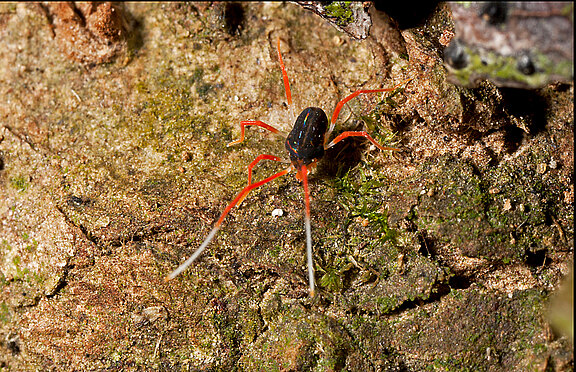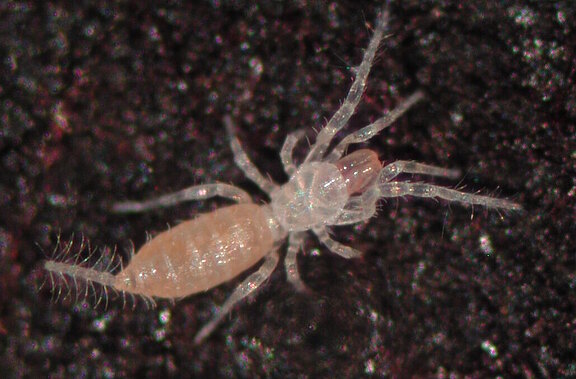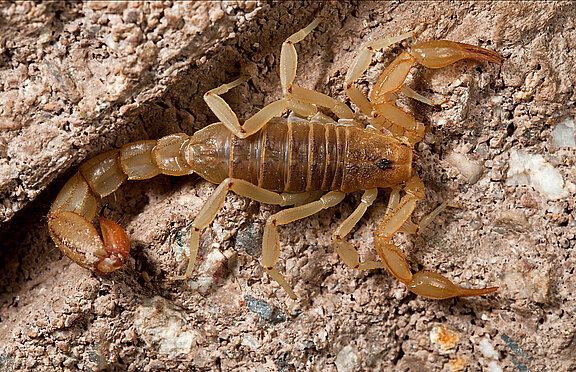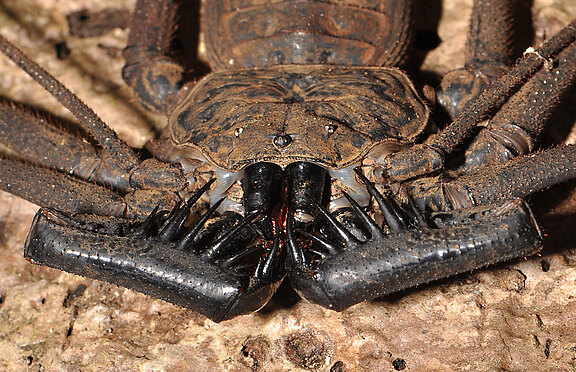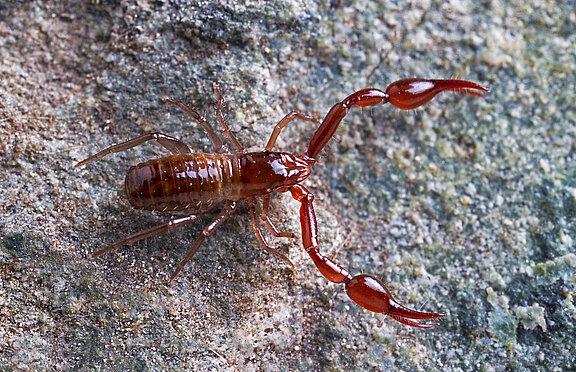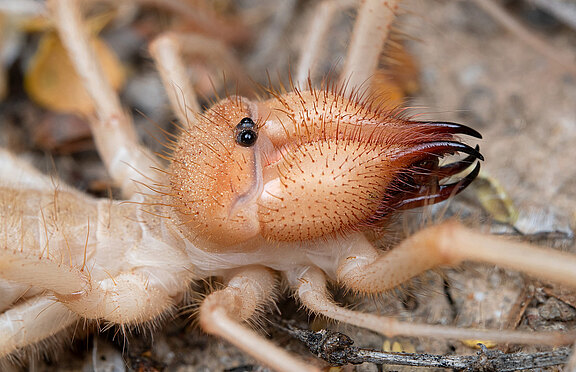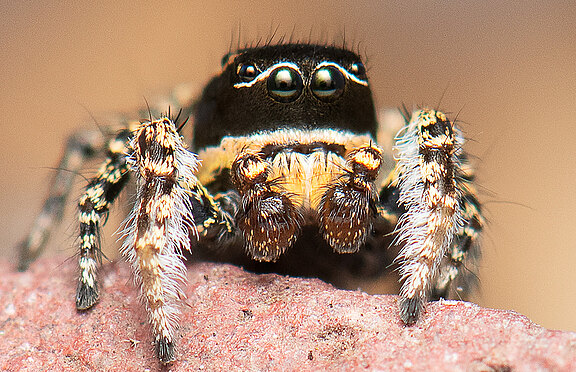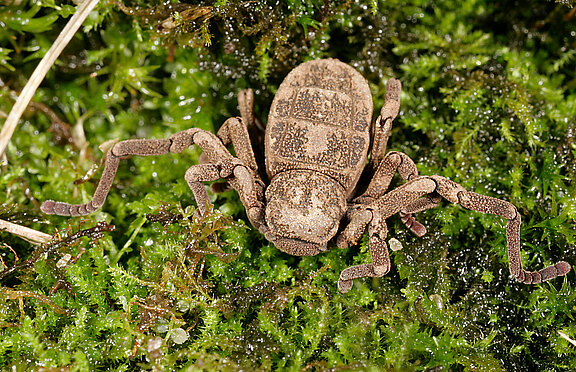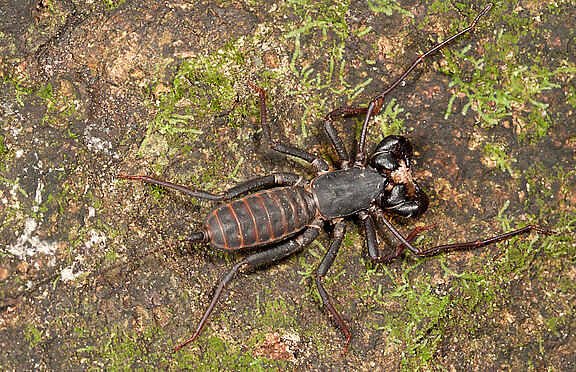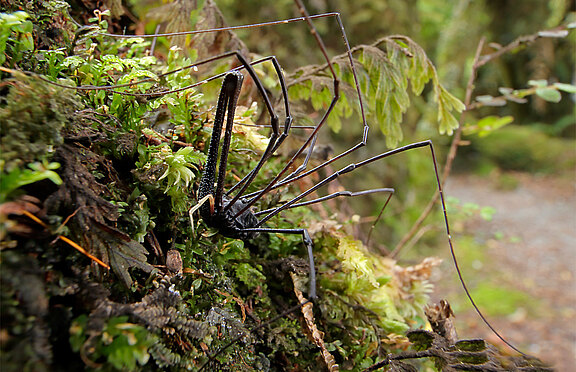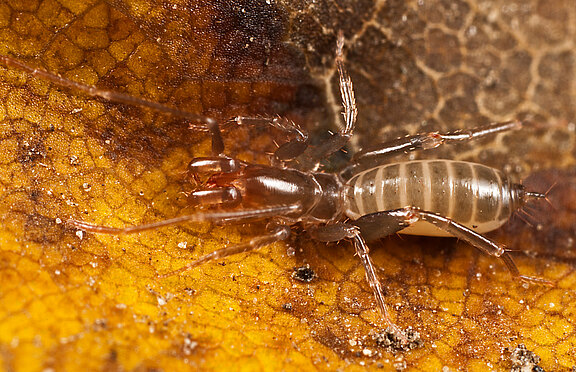Current Issue
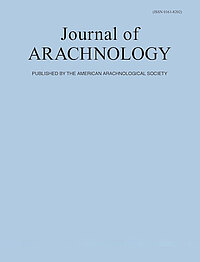
Featured Articles
An assessment of the mechanosensory responses of peg sensilla on scorpion pectines
Electrophysiology, mechanoreceptor, sensilla, resolvability
Abstract
Scorpions possess midventral touch/taste organs called pectines, which may be important for learning the nuances of the substrate during navigation as well as the detection of pheromones, spermatophores, and food. The pectines possess thousands of minute structures called peg sensilla that are responsive to both chemicals and mechanical deflection of the peg shaft. While much is known about the chemical responsiveness of the pegs, very little is known about their mechanosensory properties. Here we ask if the peg mechanosensory response is “all-or-nothing” or graded depending on the intensity of stimulation. We made electrophysiological recordings of neural activity from individual peg sensilla while deflecting the peg to elicit apparent mechanosensory responses. Our records show the presence of a rapid firing (.100 Hz), quickly adapting waveform that is indicative of a mechanoreceptor and appears to be independent of previously identified chemo-responsive cells. We tested mechanosensory response dynamics in two ways. The first test focused on a shorter-duration touch versus a longer-duration touch, while the second focused on a smaller deflection versus a larger deflection. Both pairs of stimulations (short vs long touch; small vs large touch) produced repeatable and statistically distinct responses in terms of spiking frequency. These results indicate the mechanosensory responses of peg sensilla are graded, which sheds light on the textural resolvability of the pectines and informs models of the type of information that scorpions obtain while assessing surfaces in their environment.
The natural history of Argiope anasuja (Araneae: Araneidae) with special reference to their mating behavior
South Asia, cannibalism, copulation, habitat utilization
Abstract
Argiope anasuja Thorell, 1887 is a species of orb-weaving spider found in tropical and subtropical regions of the world. Despite its widespread distribution, little is known about its natural history and mating behavior. In this study, I describe some aspects of the natural history and mating behaviors of A. anasuja in captivity and in natural habitats. The spiders were found to occupy less shady areas close to water bodies, building their webs between 50 to 200 cm above the ground level. Web decorations were common in female webs, primarily in the central area, and consisted of dense zigzag bands of silk. A significant difference in copulation duration was observed between cannibalized and non-cannibalized individuals. Furthermore, a significant difference in copulation duration was found between individuals in natural environments and laboratory conditions. However, no significant difference was observed in courtship duration between individuals in natural environment and laboratory conditions. Understanding the mating behaviors of A. anasuja is important because they play a key role in determining the success of mating. This study highlights the natural history and mating behavior of A. anasuja, contributing to our understanding of this species in Sri Lanka.
Population fluctuations in Costa Rican golden silk orbweavers (Trichonephila clavipes)
Tropical rainforest, low abundance, orb spiders, arthropod demographics, life cycles
Abstract
Globally, arthropod populations are declining at alarming rates, but the causes are rarely understood. Our research details and examines possible causes for fluctuations in the size of a Costa Rican population of golden silk orbweaver spiders (Trichonephila clavipes (Linnaeus, 1767)). Over a seven-year period from 2013–2019, we noted a sharp decline and then partial recovery of the study population during the wet season (June, July), but then failed to locate any spiders during a brief survey in June 2022 when they would otherwise be abundant. We monitored webs daily during 2013–2019 to test whether variation in prey capture, competitors, female size, male availability, predation, temperature, or rainfall related to population fluctuations. We were unable to explain T. clavipes population trends with the collected data. Future studies are needed to determine whether the extremely low population densities we witnessed in 2017 and 2022 can be interpreted as the lowest values of this species' normal population fluctuation cycle or whether these extremes are part of a long-term spider decline.
Use of geometric morphometrics to distinguish trapdoor spider morphotypes (Mygalomorphae: Anamidae: Proshermacha): a useful tool for mygalomorph taxonomy
Araneae, morphology, Stirling Range, biodiversity hotspot, taxonomy
Abstract
Taxonomic studies have evolved greatly since their early stages and new techniques have been incorporated to improve species descriptions. Those involving the comparison of traits, either quantitatively or qualitatively, can be difficult because the identification of a species must rely on the experience of the observer and errors can occur when cryptic species are involved. Molecular methods have been used to fill these gaps, but morphological methods are still needed to match the recognized molecular species with an adequate taxonomic description. Focusing on the trapdoor spider genus ProshermachaSimon, 1908, we provide a case study using Geometric Morphometrics (GM) techniques to identify morphological divergence between species found in the south-western Australia region. We used GM to identify morphological divergence from museum-preserved specimens by examining shape variation of sexual characters from 39 male specimens from five different localities on a single mountain range. Variation in the shape of both the palpal bulb and tibia provided strong evidence to distinguish two morphotypes, while metatarsus shape showed fewer between-locality differences. Our results illustrate the utility of GM methods, when applied to a few taxonomically-informative structures, as a quantitative species delimitation tool for taxonomic studies.
Spinneret spinning field ontogeny and life history observations in the spider Palpimanus uncatus Kulczyński, 1909 (Araneae: Palpimanidae)
development, molting, Palpimaninae, Palpimanoidea, spinning apparatus
Abstract
As in other Palpimanidae, two pairs of posterior spinnerets present in typical Araneomorphae are vestigial in Palpimanus uncatus Kulczyński, 1909, with only the anterior lateral spinneret (ALS) pair prominent. Nevertheless, in late juvenile and adult females, spigots appear in the ancestral posterior spinneret region (PS). Consistent with these spigots serving cylindrical silk glands, females construct substantial egg sacs. While juveniles and adults exhibit a compressed PS, in postembryos it is fully extended. Piriform silk gland (PI) spigots form a linear array on ALSs from the 1st stadium, increasing in number during ontogeny by addition of PIs of the tartipore-accommodated (T-A) subtype (i.e., functional during proecdyses). The number of T-A PIs added from one stadium to the next and locations occupied by their spigots often exhibit a stereotypic pattern, especially consistent in early instars. The number of non-T-A PIs remains constant through ontogeny from the 1st stadium: one per ALS rather than the two per ALS inferred in a few araneoids. The secondary major ampullate silk gland (2° MaA) spigot, primitively uni-shafted among araneomorphs, has become modified into a multi-shafted spigot with extended base, the number of shafts increasing during ontogeny. However, the multiple ducts that connect to the shafts continue to be accommodated during proecdysis by a single enormous tartipore. Sexual dimorphism is present, with late stadium females having greater numbers of T-A PI spigots and 2° MaA spigot shafts. Observations are presented pertaining to feeding behavior, sexual cannibalism (absent), habitat, winter diapause, numbers of molts, and longevity.
Short Communications
Facultative iteroparity in a semelparous social spider, Stegodyphus dumicola (Araneae: Eresidae)
Mating, reproduction, matriphagy, sociality, life history
Abstract
Organisms can optimize their reproductive success by differential resource allocation. When adult survival is low, investment of all resources into a single reproductive event can be beneficial, favouring a semelparous strategy. In the spider genus Stegodyphus Simon, 1873 (Eresidae), all species are considered semelparous, based on observations of ancestral subsocial species. However, derived social species show task differentiation and helping by non-reproducing females. This could facilitate a facultative iteroparous strategy by providing sufficient resources to meet the threshold for repeated reproduction. We investigated the reproductive behaviour of groups with single breeding females in the cooperative breeding Stegodyphus dumicola Pocock, 1898. We found that mothers can depart from a strictly semelparous lifestyle by producing more than one clutch. The facultative iteroparity in S. dumicola may enhance colony growth and survival, and act as a mechanism to maintain sociality.
What's for dinner? Prey consumption by Neotropical scorpions across contrasting environments
Dietary breadth, diet composition, food webs
Abstract
The overall assumption that scorpions are generalist predators is often based on conspicuous information from the literature. Here, we compiled a list of prey consumption by scorpions from different environments in Brazil to produce a documentation of predations by this taxon. This list is based on observations made under natural conditions in Atlantic Forest, Caatinga, and Cerrado formations. We compiled 135 predation instances including 11 scorpion species from field work through 14 years. The observed diet composition of the scorpions was mainly based on cockroaches, crickets, grasshoppers, spiders, and other scorpions. Such data highlights the generalist diet and cannibalism of scorpions with many cannibalistic events among the records of intraguild predation. Overall, this study broadens the knowledge of the diet composition of Brazilian scorpions under natural conditions.
Living with the enemy: behavioral study of Myrmecicultor chihuahuensis Ramírez, Grismado & Ubick (Araneae: Myrmecicultoridae)
Novomessor, Myrmecicultor, Pogonomyrmex, myrmecophile, symbiont
Abstract
The spider, Myrmecicultor chihuahuensis Ramírez, Grismado & Ubick 2019 is a myrmecophage. In an earlier study, we found that the spider's cuticular hydrocarbon (CHC) profile overlapped with that of its prey. In the present study, we photographed nests of Novomessor ants to determine whether these spiders live inside the ant nest with their prey or in the vicinity of the colony. We set up two 35 mm cameras over two main entrances of one nest of N. albisetosus (Mayr 1886) such that images would be captured of the ant colony surface (including the entrances) every 15 – 60 sec over five consecutive nights. These images included five showing M. chihuahuensis directly at one of the nest entrances investigating dead ants. The spider was not seen away from the entrance. This study provides evidence suggesting that this myrmecophage may live inside the colony with the ants it eats.

